Simple Steps to Begin Cooking Homemade: Pantry Staples
Are you working to ditch processed foods and put more real food on the table? This month we’re running a series called Real Food Made Simple: A Beginner’s Guide to Eating Better. Our goal is to answer the questions you might have and make the transition a whole lot easier!
Across the globe exists two extremes of eating: the fast food, junk and convenience food diet, and the all home-grown, whole foods diet. Somewhere in the middle is probably where most Americans fall. However, that doesn’t always mean healthy.
Small steps to homemade cooking can make a big difference. Many unnecessary chemicals can be avoided simply by making a few foods at home instead of buying packaged convenience foods. And while most of us know this, we reason that we do not cook homemade because we don’t know how or because it’s too hard or we just don’t have the time.
I was one who had the time. And I wasn’t afraid. I just didn’t know how.
The story goes that the thin-sliced pork chop that I served my newlywed husband could be used as a hockey puck, and really, it probably could have been used for such purposes.
And why? Well, because my cooking philosophy was pretty much this:
Throw something in a pan, sprinkle it with seasoned salt, and torch the thing at a high temperature until browned.
Okay, so that was 17 years, and 8 kids ago, and I have come a long way. Now the food I serve my family looks and tastes much different, and is almost never useful for sports OR ammunition.
But how did I learn?
Definitely trial and error, reading about food, spending time in the kitchen with my Mama and Grandma, and simply time and experience in the kitchen on my own have brought me a long way.
When my husband and I first started our family together, I had a short list of foods that I routinely prepared, including spaghetti (made from a box), tacos, “baked” pork chops, frozen breaded fish, vegetable beef stew, Hamburger Helper, lemon chicken, and chicken and rice.
I was happy that I served hot meals to my husband and myself and felt content with our menu, even if it was small and not always homemade.
I didn’t even think about it not really being homemade, actually. Even though it came from a box, sometimes, I still felt like I “made” it since I assembled the ingredients and heated everything.
Shortly after the birth of our second son, we moved to California, which quickly introduced us to fresher, cleaner eating. California (at least then) had a special way of helping me want to eat fresh, organic, whole food, and I began learning as much as I could very quickly.
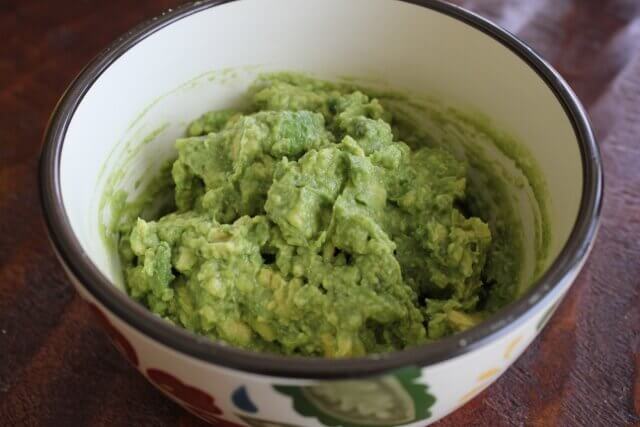
Although I probably would have found the path eventually, having been raised by a mom who was health-food conscious, I know that the move to California catapulted me in the right direction much faster. And by the time we moved back to Texas, I had quite a few new recipes in my repertoire.
From that point on, I’ve continued to learn and have gradually built up quite a large recipe box. Not everything in it is organic, or natural food, for that matter, but most of it requires cooking from scratch.
Each month during this series at Keeper of the Home, I will be posting Simple Steps to Begin Cooking Homemade. We’re going to talk about how to get started cooking from-scratch-meals in your own kitchen. During the series, we will cover the following topics:
- pantry staples (a new list each month)
- baking homemade
- soups, sauces, and easy dinners
- casseroles and freezer cooking
- cooking for a crowd
Plus, in each post, I’ll give you some menu ideas, complete with recipes for nutritious and delicious food that you can make for your family, even if you’re completely new to cooking homemade.
Let’s jump right in today and take a look at a very simple, yet helpful first step at beginning to cook homemade. You’ll see a new pantry staples list in each of the posts in this series, but for this month, it is our primary focus, so this list is considerably longer than what you may see in future posts.
A Step in the Right Direction: Get Your Pantry Ready
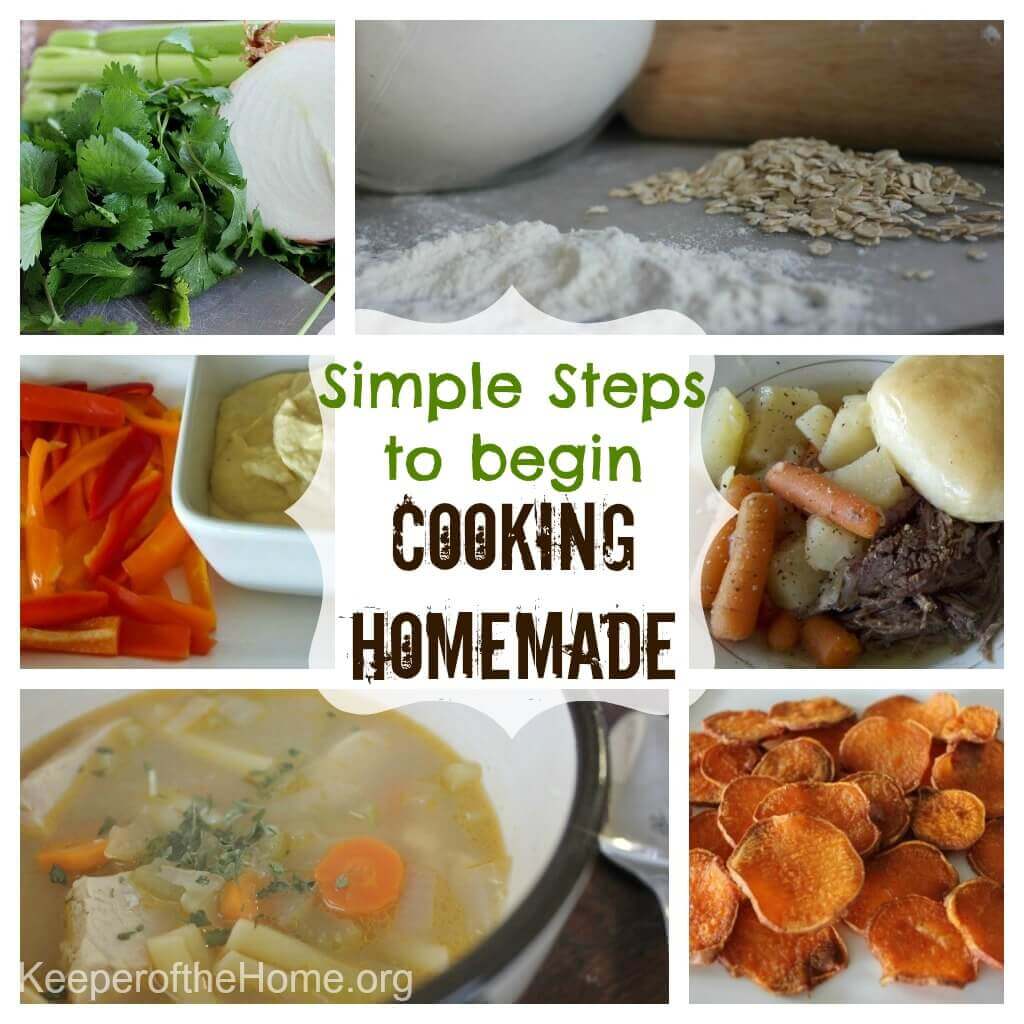
Stocking your pantry and refrigerator with some basic healthy food staples will definitely help set you up for success. Having key ingredients on hand when it’s time to cook minimizes stress, eliminates dependency on packaged convenience foods, and maximizes our possibilities.
Pantry and Fridge Staples
1. Start by slowly eliminating processed, convenience foods and replacing them with healthier options when grocery shopping. Consider replacing the following foods with their healthier alternatives:
- margarine for real butter
- canola and vegetable oils for coconut oil and organic olive oil
- processed pancake syrup for raw, unfiltered, local honey and/or real maple syrup
2. Gather, over time, if necessary, the following items to keep in your fridge and pantry that will help you get started cooking homemade:
- Real butter, both salted and unsalted – Salted butter is wonderful at room temperature for spreading on hot, fresh breads and other baked goods. Unsalted works best in baked goods.
- Organic olive oil – Olive oil is a common ingredient in many homemade dishes, both warm and cold. Useful with a little lemon juice for salad dressing, critical for homemade hummus, perfect for a quick sauté of fresh vegetables, a must for creating the perfect pasta sauce – olive oil is center stage in a homemade kitchen.
- Local, raw, unfiltered honey – This doesn’t always mean a rustic jar with the honeycomb immersed in a crystallized mixture. I am able to find our honey at various grocery stores in our area, and you may be, too. If not, you’re sure to find a local beekeeper selling honey at your local farmers’ market. Honey is important for not only serving with fresh, hot, fluffy biscuits and waffles but is the perfect substitute when you decide to eliminate white sugar, and for making these homemade chocolate granola bars, of course.
- Maple syrup – Like honey, maple syrup is the obvious choice for drizzling over breakfast foods, including the obvious pancakes and French toast, but it is often a dessert ingredient, too, as you’ll see when we explore a few easy recipes for baked goods. Maple syrup can often substitute for white sugar, too.
- Organic pasta, any type – No, store-bought pasta is not exactly homemade, but by keeping this staple in your pantry, you are better equipped to build a nutritious homemade meal around these noodles than you would be if you tried to make your own noodles from scratch right off the bat. Definitely a convenience food, but packaged separately, and organic if you can find them, they will serve your family well as you begin to explore cooking with individual ingredients versus boxed kits.
- Fresh garlic – An absolute necessity in any homemade kitchen, you’ll find that garlic is included in recipes from chicken soup to guacamole to garlic lemon chicken pasta to garlic and herb cheeseballs. And with its many health benefits and amazing ability to jazz up any dish, you’ll never want to be out of fresh garlic!
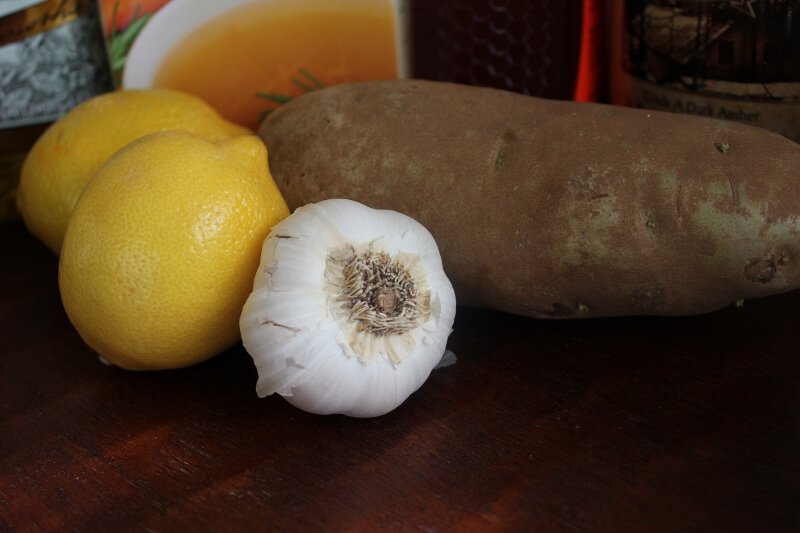
- White or yellow onions – Another very common ingredient in so many dishes–from vegetable beef stew to chicken spaghetti to pico de gallo, you never want to be without a few onions in your fridge or pantry.
- Lemons – Surprised lemons made the list for kitchen staples? Oh, but think of all the possibilities! Flavor chicken, fish, add to pasta dishes, make sauces, ranch dip, and salad dressings with fresh lemon juice.
- Potatoes – Okay, so it’s not so surprising to see potatoes here. But the often over-looked potato can be a big help in the kitchen, filling crock pots to the brim with comfort food like roast, potatoes, and carrots; pots full of creamy potato soup; and hearty chicken soup. And of course, there is always the perfect easy side in a baked potato or roasted potato wedges.
- Canned tomatoes – Once again, a convenience food makes the list of healthy pantry staples to help you cook homemade. And why canned? Because a can of organic crushed or diced tomatoes goes a long way in helping create delicious homemade pasta sauces, delicious soups, and even salsa!
- Dried herbs and spices – As you are able, collect herbs and spices, including cinnamon, chili powder, cumin, garlic powder, onion powder or dried onion, dill, chives, and parsley. Having these ingredients will give you instant access to making your own homemade chili, taco seasoning, ranch dressing, and more! Start with these and branch out as you get more comfortable with exploring more flavors and recipes.
- Organic chicken broth – Not just for soups, chicken broth is a great way to boil pasta, rice, and quinoa, and is an ingredient in many casseroles, too. You can easily make your own, but we won’t get ahead of ourselves quite yet!
- Brown rice and quinoa – Perfect for quick, nutritious sides, both rice and quinoa offer versatility, nutrition, and customized flavors to complement any dish you create.
- Chicken, fish, and a variety of meats – The obvious main course for many meals, by keeping an assortment of meats in your freezer, you’ll be ready to cook without having to run to the store at rush-hour.
Simple Recipes to Help you Begin Cooking Homemade
Here is a sample menu of simple, easy dinners for you to experiment with over the next few weeks. Don’t be afraid to embrace the slow cooker, as it is a wonderful way to accomplish serving delicious, hot, homemade meals to your busy family.
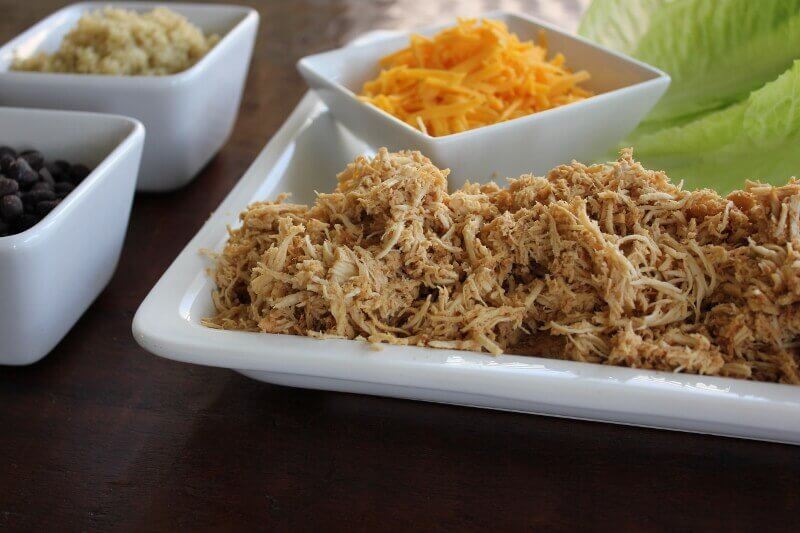
Baked Tilapia, served with brown rice, and salad
Crock Pot Chicken and Vegetables
Crock Pot Roast with Potatoes and Carrots
Garlic Spaghetti, served with salad
Other posts in the series:
Real Food Made Simple: A Beginner’s Guide to Eating Better
Cutting Your Kitchen Prep Time in Half — Or More!
Confessions of a Formerly Picky Eater
The Grain Controversy: Should We Eat Them or Not?
Second Steps Towards Eating Real Foods: Switching Your Food Sources
Sweeteners: How They Affect You, Which Ones are Best, and How to Use Them
5 Strategies to Help Your Husband and Kids Transition to Real Food
Finding Real Food in the Grocery Store
20 Easy Real Food Switches and Substitutions {with Free Printable Chart}
First Steps to Eating for Fertility
Keeping Costs Down in a Real Food Kitchen
5 Ways to Get More Fruits & Veggies into your Diet
Food Is Not Cheap: 4 Steps to Budgeting in Real Food
Simple Steps to Begin Cooking Homemade: Baked Goods
Simple Roast Chicken (And Fabulous Side Dish Recipes!)
17 Homemade Spice Mixes {with Recipes & Why You Should Use Them!}
5 Ways Green Living and Real Food are Connected
Simple Steps to Begin Cooking Homemade: Soups, Sauces, and Simple Dinners

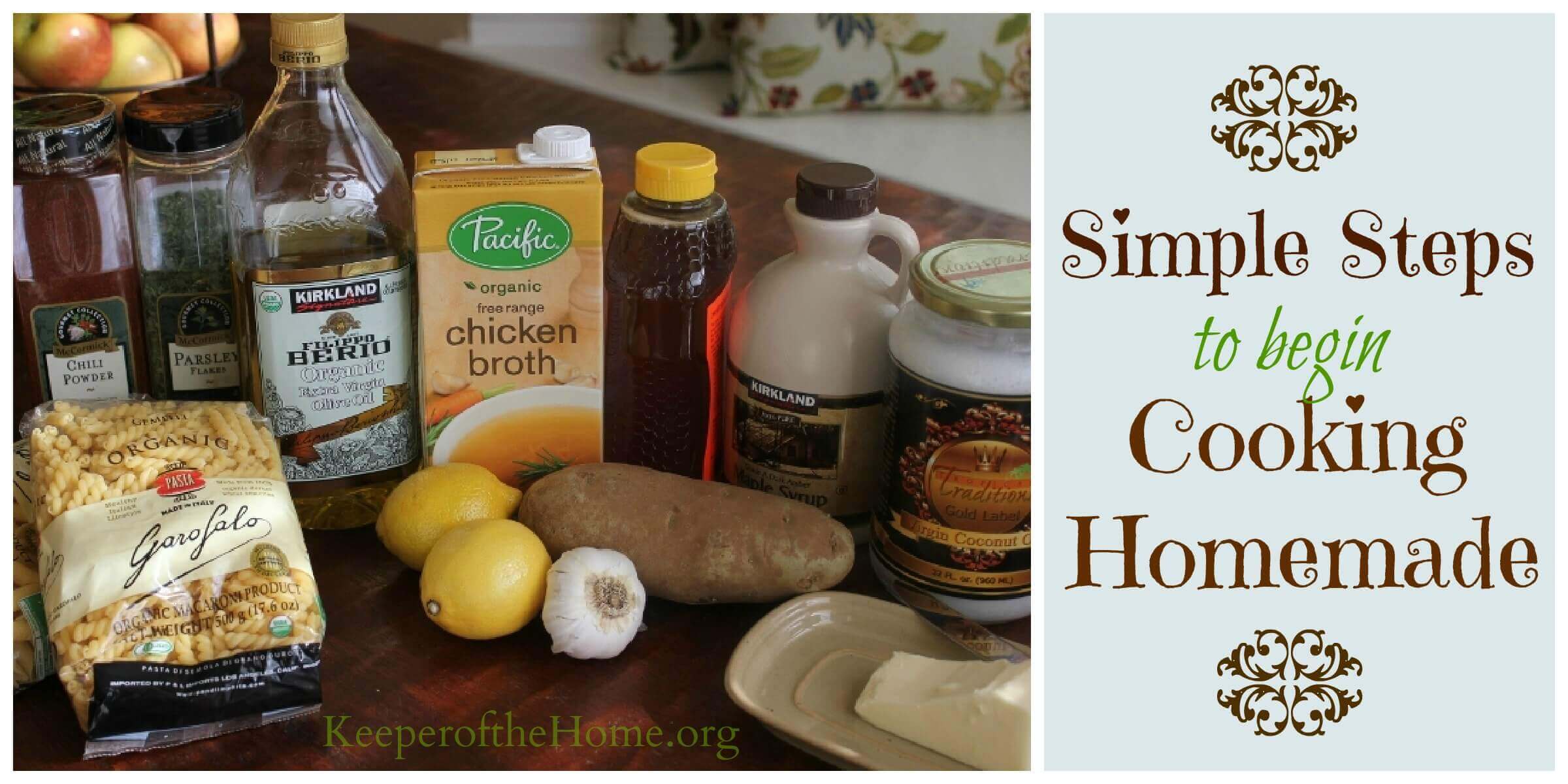


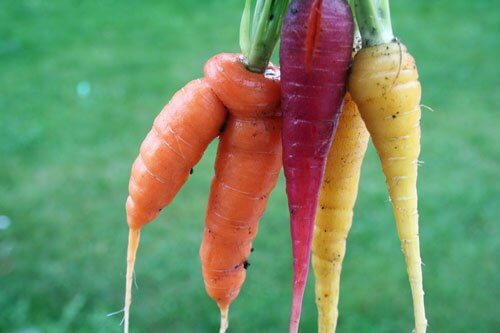
I am new to healthy home made! I need the recipes for how to use such things as quinoa. I look forward to taking this journey with you.
I love the fact that you started this series! We make a lot of things homemade, but I want to branch out, there is always room for improvement! This is a wonderful list and we have almost every single thing on it I am proud to say 🙂 Since we stepped back from processed foods, we feel so much better and healthier.
It’s encouraging to think how much more in step we are with this list than a year ago. I’d never go back. One questions though; I’ve always avoided salted butter because I figure even the organic/grass-fed stuff has processed salt. Is that not true? We currently mix our own butter with Real or Celtic salt into a warm butter spread for bread or eat it unsalted.
Sounds like you’ve got that figured out, Amanda! Good job! 🙂
Hey! New to Keeper of the Home 🙂 LOVING this. My family and I have been on a similar journey to cleaner eating. It is AMAZING what the food GOD created can do for you!!! Keep up the good work, my friend XO
Looking forward to this series! Thanks!
We are coming along well in our real food journey. I’ve been cooking homemade and semihomemade since getting married 21 years ago. I’m just now eliminating HFCS and BPA and GMO’s as best as I can. You mentioned buying canned tomatoes… I hesitated at the grocery store last week even on the organic ones because I thought buying anything in a can could contain unwanted chemicals from the can. I’m getting confused trying to process everything. We do can our own tomatoes from the garden which I know this would be the best but sometimes we only have a small supply. Is there some label on the can you look for before buying? This was my concern buying black olives too. Thanks
Hey Kristy! Congrats on 21 years!!! Wow!
GMO’s can be tricky, especially since we have to guess (at least in the U.S.) what they are and are not in. 🙁 About canned tomatoes, if you can can your own, then go for it! I used to do that a few years ago when we had a large back yard, but when we moved, our new home had a much smaller backyard. (I am going to be exploring the Suburban Backyard Gardening technique this summer, though – Yay!) The reason I suggested canned (and organic) tomatoes is because they can be a lifesaver to a mom who is new to cooking homemade. Can you imagine? Asking her to can her own tomatoes first? 😉 As far as labeling, I do know that often, organic products will be labeled BPA free. And Muir Glen, supposedly DOES package BPA-Free! 🙂 Here’s the link: http://www.organicconsumers.org/articles/article_20714.cfm
Thanks Brandy for your reply and the link. I’m finding out so much good information from this series.
It has helped me so much. Good luck with your gardening adventure, Sometimes by the end of the harvest I run out of steam for canning it all! Congratulations to you on your beautiful family as well. We are blessed.
Loving this new series, Brandy, so glad you suggested doing it! I had to go through a similar process as you did, when I was a new bride and had no idea how to cook. I only wish someone had written a series like this for me! 🙂
I’m happy to do it, Stephanie. It definitely was and still is, a learning curve. We’re always learning, aren’t we? 🙂
I have been slowing changing things over at our place for the past year and I am happy most of the above changes have already been done. I am so excited about what changes will happen in the next year!
I’ve been a stickler for homemade foods for some time; however, I do tend to use a lot of convenience items (such as canned beans or canned tomatoes). One of my goals this year is to cut down on how many of these items I use.
As Kristy mentioned before me, I’m concerned about compounds such as BPA. Are there any brands that have less of this in their cans or that have gone BPA-free?
Shannon, you may be pleased to read this: http://www.organicconsumers.org/articles/article_20714.cfm This is the brand of tomatoes I am referring to and the ones I currently use. If I had a backyard garden (like I used to) we would make everything from scratch. But I feel good about using these on occasion to help feed my family nutritious meals.
I would love to hear your budget for this each month or every few months. One of my goals for this year is to really get our pantry into shape. My hope is that by having it stocked well, I’ll be able to save some of our grocery money each month to purchase a large amount of grass-fed beef.
Looking forward to this series!
Awesome, wonderful, simple, basic article! I have been making the switch to organic and homemade over the past couple of years and was happy to see that even though I wasn’t following you when I started my journey (thus have taken the more difficult route ;), that my pantry had been switched over to all of your suggestions! I love my local food co-op and our meat CSA. I have many friends wanting to follow our healthy example and this post will be my go-to article for their beginning steps in their kitchens! But recently, a friend shared with me the following article and I’ve had to take quinoa off my shopping list. I think it’s important for us to be aware that in some cases, our desire to be healthy can greatly hurt someone else’s ability. http://www.guardian.co.uk/commentisfree/2013/jan/16/vegans-stomach-unpalatable-truth-quinoa
I’ve been on my real food journey for probably about a year, and have made a lot of progress. You mentioned replacing white sugar with honey or maple syrup, but do you have a preferred substitute ratio (as in, a half cup of honey = a cup of white sugar, or whatever it is)? Or is it different depending on what you’re making? Do you have a good reference for this?
As it is now, I always make sure I am getting sugar labeled cane sugar, because unlabeled likely comes from sugar beets, which are often GMO. I try and get turbinado or Florida Crystals brand when I can afford it. Maple syrup wouldn’t be any cheaper, but honey might work, so I’d appreciate any info! Thanks!
I try and make real food each and every day. I am the CEO of a company, have three kids and well, not a lot of time. I try and prepare a menu for 4 weeks at a time. Do one massive shop (including a trip to that warehouse store) and a quick shop about every 6 days to get fresh veg and fruit. When I know I am going to be swamped with work, I take a Saturday and fill my freezer with casseroles, soups, etc. I love suppertime, it is my favourite time of day with my brood (although bedtime is pretty sweet as well)
I almost always have some homemade chicken broth in the freezer. It’s not organic, yet. I haven’t figured out how to work organic meats into our budget, but I’m working on it. I didn’t realize how easy it is to make. I just add a little water when I am “roasting” chicken thighs in the crockpot and then once it is cool, I strain it into a large bowl, place it in the fridge overnight, scrape the hardened fat off the top (I’ve heard you can save that and use it in savory pie crusts…like for meat pies, but I haven’t gotten brave enough to make my own pie crusts yet either) and then freeze the broth in usable portions. It tastes so much better than canned broth.